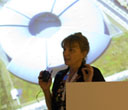ALBA Synchrotron

From September 3rd to 6th, more than a hundred researchers are meeting at ALBA Synchrotron to attend the VI National Meeting of the Spanish Synchrotron User Association (AUSE) and the 1st ALBA User Meeting. During the week, researchers will have the opportunity to showcase their results and discuss about the different applications of synchrotron light.
During the opening ceremony, Caterina Biscari, director of ALBA Synchrotron, has highlighted that "the dream of creating a Spanish synchrotron is now a reality". On behalf of AUSE, her president María Eugenia Dávila, has remarked on "the tremendous progress that synchrotron science has experimented in the last years in Spain".
New this year, a full day session is dedicated to the applications of synchrotron light in the biomedicine sector. Renowned international experts, for instance Paul Dumas, from the infrared beamline of Soleil Synchrotron (France), are attending the session. Dumas will explain how synchrotron light can be used to identify the nature of kidney stones. Other researchers will talk about synchrotron light usage in the diagnosis and prevention of illnesses and in the resolution of 3D structures of directed biomolecules for regulating cholesterol or hypertension.
Among other novelties from the IV AUSE National Meeting, the 2013 AUSE Thesis Prize for the best doctoral thesis using synchrotron radiation defended in a Spanish university between 2011 and 2012 was awarded to Immaculada Martínez Rovira, who studied radiotherapy techniques using spatially fractionated dose with synchrotron radiation. These techniques are used on cancer treatment (for example, in brain tumors), where there is evidence of a notable resistance towards the healthy tissue while slowing down tumors in trials performed with small animals.
Spanish synchrotron user community grows up to 630
The interest in synchrotron light in Spain has been growing considerably over the last ten years. At the moment, AUSE has registered 630 Spanish users of synchrotron light while there were only 200 in 2004.
The start of ALBA Synchrotron in 2012 has led to a growing usage of synchrotron light in Spanish science. ALBA’s seven experimental beamlines, all part of Phase I and in full operation at the moment, allowed 354 researchers to perform their experiments. 77% of all received proposals come from Spanish research institutions while the rest mainly come from other European countries, allowing them to be performed in their home country.
Research projects developed at the ALBA Synchrotron during the last year are mainly focused on protein crystallography (39%), followed by material sciences (25%), physical biology (11%), chemistry (8%), soft matter (5%) and environment (1%).
ALBA Synchrotron Light Source has been raising a growing interest among the Spanish scientific community, with 1.183 researchers registered in their user database, among them 846 Spaniards.
More information and programme:
http://albausermeeting2013.cells.es/

